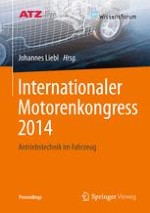2014 | OriginalPaper | Chapter
Kraftstoffeffizienz als Herausforderung zukünftiger Nutzfahrzeugantriebe
Authors : Wolfgang Schöffmann, Dr., Helfried Sorger, Dr., Georg von Falck, Dipl. -Ing, Kurt Schmidleitner, Dipl. -Ing., Heimo Schreier, Dipl. -Ing., Georg Biegelbauer, Dr.
Published in: Internationaler Motorenkongress 2014
Publisher: Springer Fachmedien Wiesbaden
Activate our intelligent search to find suitable subject content or patents.
Select sections of text to find matching patents with Artificial Intelligence. powered by
Select sections of text to find additional relevant content using AI-assisted search. powered by
Compliance with emission regulations had set the boundary conditions for the layout of commercial engines in recent years. New engines had been developed, providing significantly increased power density beside conformance to emission limits.
The future focus on further significant reduction in fuel consumption requires a holistic view of the commercial powertrain architecture including engine and transmission concepts beside further optimization of the base engines.
Downspeeding is a promising approach, particularly for engines in the long-haul sector, whereby the operating range of the engines is being pushed to lower engine speeds. In order to ensure sufficient climbing ability and drivability in lower gears, the torque characteristic of future engines must be adapted. The combination with a power shift transmission, particularly a double-clutch transmission is necessary or at least beneficial.
In the definition of new Heavy Duty engines special attention has to be given on the increasing mechanical and thermal loads on the engine structure, on one hand to reduce the engine weight by a light weight design approach, on the other hand to achieve the complete fuel reduction potential by friction optimisation.
At the same time cost reduction at the base engine is a premise, in order to at least partially compensate the increasing technology cost of the additional powertrain components. This leads to high requirements on the engine manufacturing strategy, accompanied with the need to consider a large variety of variants in unpredictable volume splits.
Accurate concept evaluation and optimisation, supported by state of the art CAEtools, provide further potential for friction reduction at the base engine, in particular in the areas cylinder running surface and crankshaft bearings.
An even larger friction reduction potential is to be expected in future by further development of surface coating technologies, although their current cost level partially still reflects low volume production methods.
Further improvements are available by application of additional technologies, such as on-demand controlled pumps and auxiliaries, or thermal management.
